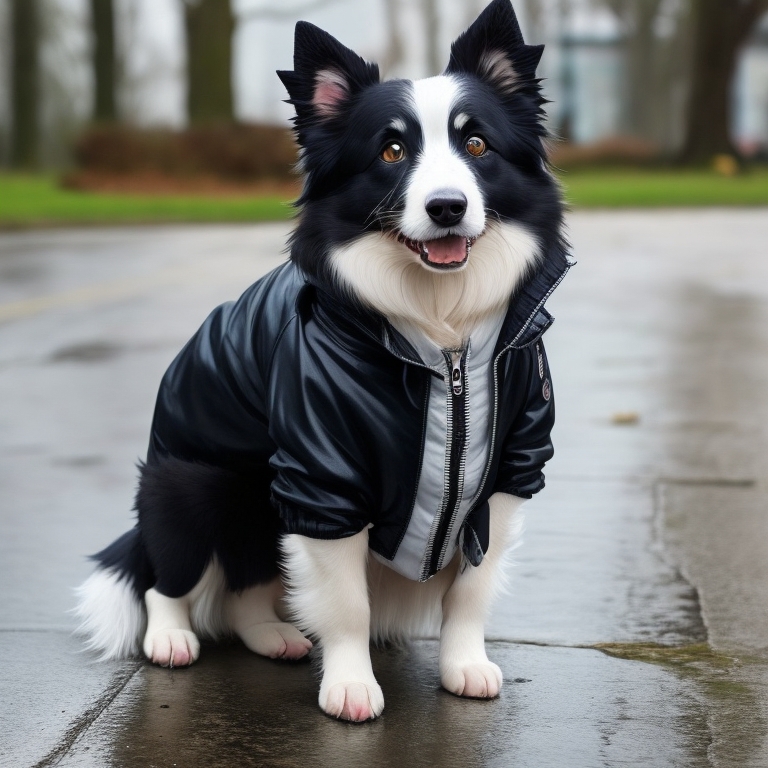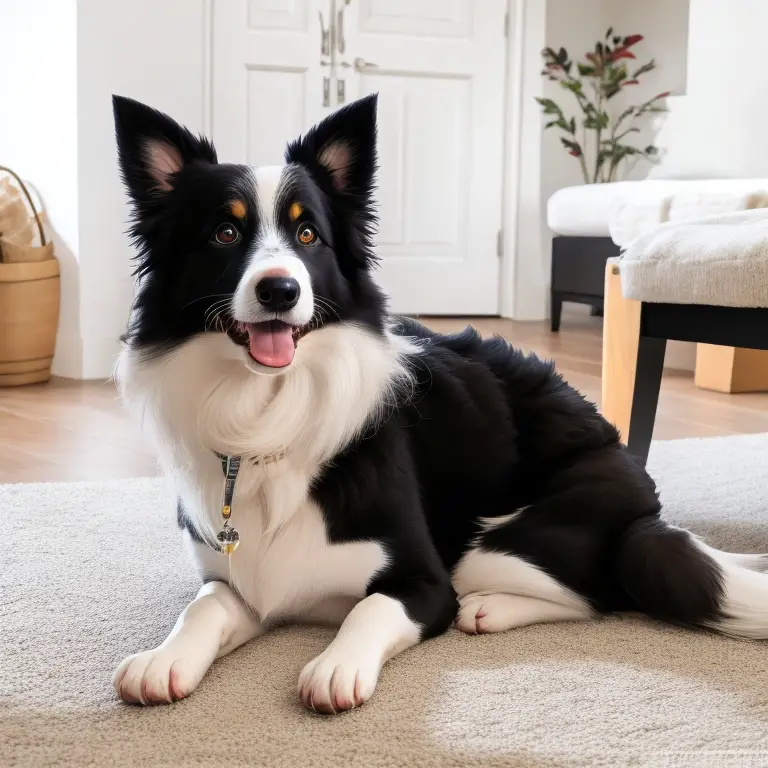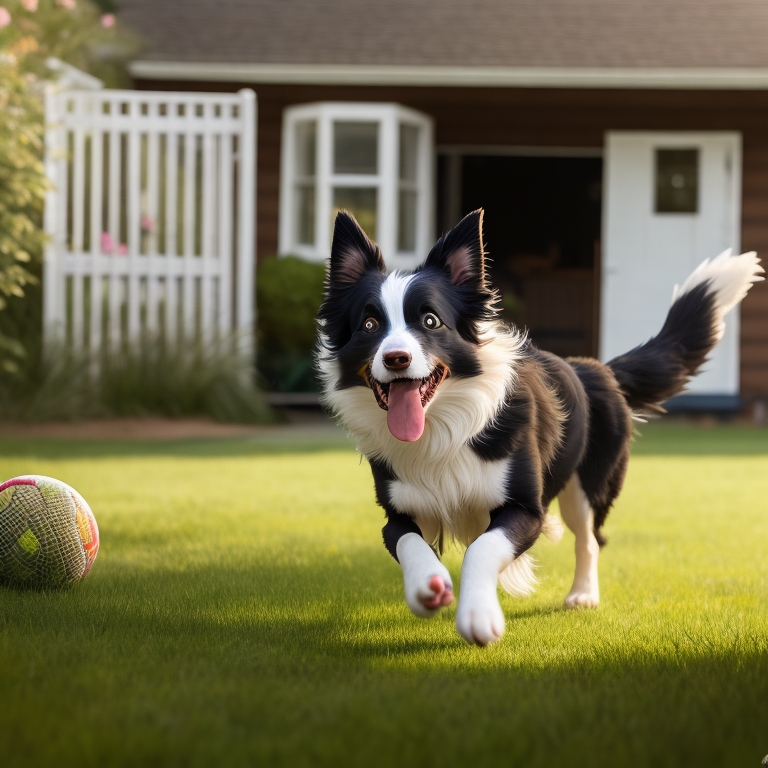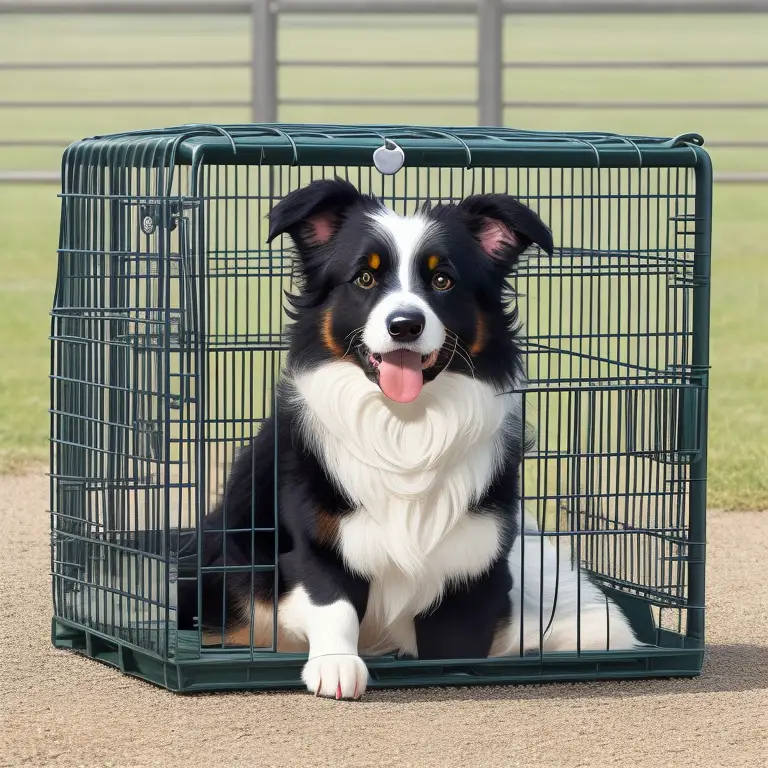How To Teach a Border Collie To Stay Or Wait On Command?
So, you’re a proud Border Collie owner, and now you want to teach your furry friend some impressive tricks like ‘stay’ or ‘wait.’ Great decision! Border Collies are highly intelligent and trainable, and with the right methods, you can easily teach them obedience commands. Teaching your dog to stay or wait on command can help prevent accidents and keep them safe in different situations.
However, training a dog requires patience, consistency, and proper techniques.
In this blog post, I will guide you through the process of teaching your Border Collie to stay or wait on command in easy-to-follow steps. Ready to get started?
Let’s dive in!
| Step | Description |
|---|---|
| Step 1 | Give the “sit” command and wait for your Border Collie to sit. |
| Step 2 | Raise your hand with your palm facing out and say “stay” or “wait”. |
| Step 3 | Take a step back while keeping your hand raised and continue to say “stay” or “wait”. |
| Step 4 | If your Border Collie stays, praise and treat them. If they move, calmly return them to their starting position and give the “sit” command again. |
| Step 5 | Gradually increase the distance between you and your Border Collie while remaining consistent with the “stay” or “wait” command. |
| Step 6 | Practice in different environments and with distractions present to reinforce the behavior. |
Understanding the Border Collie Breed
Characteristics of Border Collies
Border Collies are a highly intelligent breed known for their high energy levels and incredible work ethic. They are herding dogs, originally bred for working on farms herding livestock, but have become popular as pets and performance dogs due to their natural abilities.
Here are some key characteristics of Border Collies:
- High Energy Levels: Border Collies are known for their boundless energy. They require plenty of exercise and mental stimulation to stay happy and healthy.
- Intelligence: Border Collies are considered one of the smartest dog breeds. They are quick learners and thrive on mental challenges.
- Work Ethic: Border Collies are bred to work and are happiest when they have a job to do. They thrive on challenges and excel in tasks that require focus, precision, and attention to detail.
- Natural Instincts: Border Collies have a strong herding instinct and may have a tendency to herd children, other pets, or even cars.
- Trainability: Due to their high intelligence and work ethic, Border Collies are generally easy to train. However, their natural herding instincts can sometimes make training a challenge.
Understanding these key characteristics of Border Collies is essential when it comes to training. Adequate exercise, mental stimulation, and a clear understanding of their natural instincts will help you train your Border Collie more effectively.

Why Border Collies Are Easy to Train
Border Collies are known for their intelligence, agility, and high energy levels. These characteristics make them easy to train, as they are highly receptive to learning and eager to please their owners.
Their intelligence allows them to understand complex commands quickly and remember them for future training sessions.
Additionally, their agility and energy levels make them highly motivated to learn and respond to new commands. Border Collies are also highly sensitive to their owner’s emotions and tone of voice, making positive reinforcement training a highly effective technique.
They respond well to praise and rewards, which helps to reinforce desired behaviors.
Overall, Border Collies’ intelligence, motivation, and sensitivity make them an easy breed to train. With consistency, patience, and positive reinforcement, you can successfully teach your Border Collie a range of commands, including the stay or wait command.
Preparing for Training
Establishing a Training Routine
The key to training a Border Collie successfully is establishing a consistent training routine. Setting a routine will create a predictable environment for your dog to learn and thrive.
Here are some essential steps for establishing a training routine:
- Choose a specific time and place for training. Consistency is key, so find a location where you can practice regularly with minimum distractions.
- Keep training sessions short yet frequent. Ten to fifteen minutes of training sessions, two to three times a day, is ideal for a Border Collie.
- Use positive reinforcement and reward your dog after every successful training session. Positive reinforcement is an effective way to motivate your dog to repeat desirable behavior.
- Incorporate playtime into your routine. Border Collies love to play, and it’s an excellent way to reward your dog and improve your bond while training.
By establishing a training routine, you’ll help your Border Collie learn faster. With dedication and consistency, you’ll be well on your way to teaching your dog to stay or wait on command.
Gathering Training Materials
To successfully train a Border Collie to stay or wait on command, you need to gather a few training materials. These materials include several toys, a collar, a leash, and some treats.
Toys are important because sometimes during training, dogs tend to get bored.
The collar and leash are also necessary to help you control the dog’s movements during training sessions. Finally, treats are crucial for rewarding good behavior, which helps reinforce the training.
Having these materials ready before you start your training will make the process smoother and more efficient.

Basic Training
Teaching Basic Commands
Teaching basic commands such as Sit, Stay, and Come are essential for any dog’s training, including Border Collies. To teach these commands, it’s important to use positive reinforcement and rewards.
Start teaching Sit by holding a treat close to the dog’s nose and then slowly lifting it up, which will encourage them to sit naturally.
When they do, reward them with the treat. To teach Stay, begin by having your dog sit and then take a step back, saying “Stay” clearly while holding up your hand in a “stop” position.
If your dog stays, reward them with a treat.
Gradually increase the time and distance of the stay as your dog practices. To teach Come, start by having your dog on a leash and then call their name followed by “Come” while backing away from them.
When they come towards you, reward them with a treat.
Consistently practice these commands every day, and your Border Collie will quickly learn the basic commands.
The Importance of Positive Reinforcement
Positive reinforcement is an essential tool in training Border Collies. This method involves rewarding your dog for displaying the desired behavior, making them more likely to repeat it in the future.
The use of positive reinforcement has many benefits, such as creating a positive interaction between the owner and the dog, building trust, and fostering a good relationship.
Positive reinforcement can also help to avoid undesirable behaviors such as aggression, anxiety, and fear. This is important because Border Collies can become anxious if you use negative or harsh training methods.
Using positive reinforcement can improve their confidence and help your Border Collie feel happier and more relaxed around you.
When using positive reinforcement, it is crucial to use verbal praise, treats, and toys as rewards. The treats used for training should be small and flavorful, and the toy used should be something your dog loves.
The verbal praise should also be enthusiastic enough to indicate that you are pleased with their behavior.
To summarize, positive reinforcement is a useful and humane technique when training Border Collies. With this method, you can encourage good behavior, build a trusting relationship with your dog, and avoid negative consequences of punishment-based training methods.

Teaching Stay or Wait Command
Introducing the Command
When it comes to teaching your Border Collie to stay or wait on command, the first step is introducing the command. Start by using a clear and concise verbal cue, such as “stay” or “wait”.
Make sure to use the same cue consistently every time you want your dog to hold the position.
To introduce the command, begin by having your dog sit or lie down. Say the verbal cue and then take a step back.
If your dog stays in position, praise and reward with a treat.
Gradually increase the distance and time you ask your dog to wait. It’s important to avoid using physical force or punishment when teaching the stay or wait command.
This can cause fear or discomfort and may discourage your dog from learning.
Instead, focus on positive reinforcement and praise your dog for good behavior. Remember to keep your training sessions short and consistent, and always end on a positive note.
With patience and practice, your Border Collie can learn to stay or wait on command.
Teaching the Stay or Wait Position
Teaching your Border Collie to stay or wait on command can be a valuable skill that helps to improve obedience and safety. To get started, begin by introducing the command and showing your dog what the position looks like.
To teach the stay or wait position, choose a spot with little to no distractions and call your dog’s name.
Once your dog is facing you and paying attention, hold your hand up and say “stay” or “wait” in a definitive, calm tone. Then, take a step back while saying “good stay” or “good wait”.
If your dog stays in position for a few seconds, praise and reward them with a treat or verbal praise.
Repeat this process and gradually increase the duration of the stay or wait. It is essential to build up this skill gradually to ensure that your dog understands and can perform the position consistently.
If your dog struggles to stay or wait for extended periods, start by reducing the duration and gradually build it back up.
Adding distractions and distance to the training is another important step in teaching stay or wait commands. Begin with simple distractions such as a toy or food placed nearby and gradually add more complex distractions.
Consistency and patience are crucial to successfully teaching stay or wait command.
Practise regularly, and do not hesitate to go back to basics if your dog seems to forget the position. With time and persistence, your Border Collie will learn to stay or wait on command effectively.

Increasing the Duration of Stay or Wait
To increase the duration of stay or wait, you should begin by gradually extending the amount of time your Border Collie remains in the position. After your dog has learned to hold the position for a few seconds, gradually increase the time they have to stay or wait before releasing them.
Consistency is key when increasing the duration, so make sure to practice this part of the training regularly.
It’s important to note that you should never leave your dog in the stay or wait position for an extended period as it can cause stress or discomfort. Instead, increase the time gradually and reward your dog for remaining in the position.
Additionally, always reward your dog for successful stays or waits.
Using positive reinforcement, such as treats or verbal praise, will help reinforce the behavior. Gradually decrease the frequency of rewards as your dog becomes more successful in holding the position for longer periods.
Training should also be done in a quiet and familiar environment, free of distractions.
As your Border Collie becomes more confident in holding the position for longer periods, slowly introduce distractions, such as toys or people, and gradually increase the distance between you and your dog. Remember, patience and consistency are key when training your Border Collie to stay or wait on command.
With the right approach and practice, your dog will master this essential skill.
Adding Distractions and Distance
Once your Border Collie is comfortable with the stay or wait position for an extended period, you can start increasing the level of difficulty. Start by introducing different distractions gradually.
At first, use something minor such as a bouncing ball or treat in front of them to make them lose concentration.
Gradually work your way up to more challenging distractions like a squirrel or loud noises. Another essential factor to consider is distance.
Start by staying close to your dog and gradually increasing the distance while they are in the stay or wait position.
Start by taking a single step, then two, then a few more, then further away. Always keep the distance you plan to walk away from your dog constant and avoid increasing it too quickly.
Make sure that your Border Collie has mastered the stay or wait command correctly before adding challenges such as distraction and distance.
Remember to use positive reinforcement and encourage, rather than punish them when they break the command. Be patient, and with time, your furry friend will be able to stay or wait on command even with distractions and distance.
Practicing Consistently
Practicing consistently is crucial when teaching your Border Collie to stay or wait on command. It’s best to set a regular training schedule and stick to it, even if it’s just for a few minutes each day.
This will help your dog understand that training time is a regular part of their routine, leading to better retention and faster progress.
During your training sessions, be sure to start with short durations and slowly increase the time your dog has to stay or wait in position. You can also gradually introduce distractions and distance as your dog becomes more comfortable with the command.
It’s important to remember that every dog learns at their own pace, so don’t get discouraged if progress seems slow.
Stay positive and continue practicing consistently, and you’ll soon see your Border Collie following the stay or wait command with ease.

Troubleshooting Common Problems
Breaking the Stay or Wait
Sometimes, you might experience some challenges when it comes to keeping your Border Collie to stay or wait in one place. Some of the common issues that arise include breaking the stay or wait, ignoring the command, and passive resistance.
Breaking the stay or wait command occurs when your Border Collie does not maintain the stay or wait position and instead stands up, walks away, or moves towards you.
To address this, you need to establish shorter durations and gradually increase the duration. Practicing consistency, increasing the distance, and reducing distractions can also help.
If your Border Collie is ignoring the command, you can try to rephrase the training or offer treats to boost their motivation.
Passive resistance occurs when your Border Collie refuses to move from one position to another. This may require you to start training afresh and using positive reinforcement to make it more enjoyable.
Remember to remain patient and consistent throughout the training process, as it may take some time for your Border Collie to master the stay or wait command.
By addressing these common challenges, you can successfully teach your Border Collie to stay or wait on command.

Ignoring the Command
If your Border Collie is ignoring the ‘stay’ or ‘wait’ command, it could be due to a lack of understanding, training, or distractions in the environment. Here are some steps to help you troubleshoot:
- Reinforce the training of previous commands to build a stronger foundation of obedience before teaching the stay or wait command.
- Use positive reinforcement like treats, praise, or toys to motivate your Border Collie to follow the command.
- Practice in a controlled environment with minimum distractions, then gradually increase the level of distractions as your dog improves.
- Make sure to use a clear and consistent verbal command every time you teach the ‘stay’ or ‘wait’ position.
- If your Border Collie is still not following the command, check for any underlying medical conditions or pain that may be affecting their ability to concentrate.
Remember, consistent practice and patience are key to successfully teaching the ‘stay’ or ‘wait’ command. Don’t give up and keep practicing until your Border Collie masters the command.

Passive Resistance
Passive resistance is a common issue when training a Border Collie to stay or wait on command. Your dog might hesitate or avoid the position altogether.
This can be frustrating, but it’s essential to stay patient and calm.
To overcome passive resistance, you must first check the duration and distance of the stay or wait command. If the duration or distance is too long, your dog might be overwhelmed or uncomfortable.
Take a step back and start with shorter durations and closer distances.
Another solution is to use positive reinforcement. Use treats, praise, and affection to motivate and encourage your dog to stay or wait.
Avoid punishment or scolding as it can harm your dog’s confidence and trust.
Consistency is also crucial. Ensure that you’re using the same command each time, and your behavior is consistent.
Inconsistent training can confuse your dog, leading to passive resistance.
Finally, check if there’s an underlying issue. Your dog might be experiencing pain or discomfort that’s causing them to resist.
If this is the case, consult with your veterinarian.
Addressing passive resistance requires patience, consistency, and positive reinforcement. By implementing these solutions, you can effectively train your Border Collie to stay or wait on command.

Conclusion
In conclusion, teaching your Border Collie to stay or wait on command can be a challenging, yet rewarding process. With patience, consistency, and positive reinforcement, your dog can become an expert at holding still in various situations.
It is important to remember that every dog learns at their own pace, so don’t get discouraged if progress is slow at first.
Also, always prioritize your dog’s safety and well-being when practicing this command. Overall, training your Border Collie to stay or wait is an excellent way to improve their obedience and create a stronger bond between you and your furry friend.
With the right approach and mindset, you can successfully teach your dog this valuable skill.
So, get started with these tips and watch your dog develop into a more well-behaved and responsive companion.







